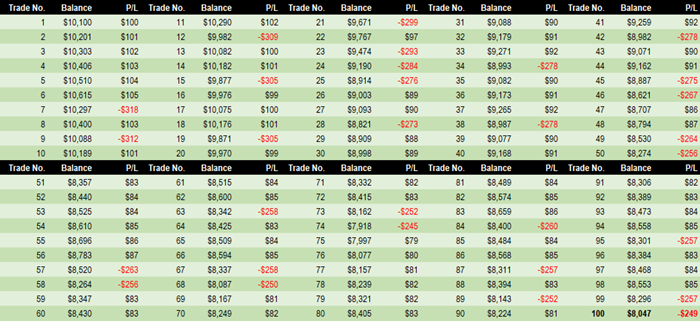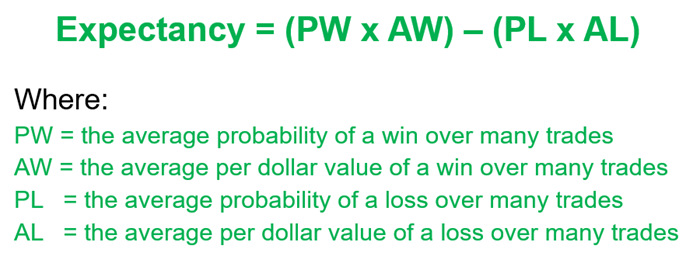It's fair to say that most traders are obsessed with scoring winning trades. Why wouldn't you be!? But, a total focus on making every trade a winner should not be the be-all and end-all of one's trading and investing goals. In this article, we'll demonstrate strike rate is not necessarily the key to investing success.
Highlights
- What is strike rate?
- What is the importance of strike rate?
- What is a good strike rate?
- Expectancy
What is strike rate?
The number of winning trades you make versus the number of losing trades you make is referred to as your "strike rate". We all love the feeling that comes with a winning trade. Firstly our investing account enjoys the extra capital, but perhaps most favourably, we enjoy a little self-patting on the back and the positive reinforcement that comes with a win.
However, while strike rate might be the quickest way to pad your ego and impress your friends, it doesn’t mean a great deal when it comes to consistently achieving your long term investing goals. Like many of the key investing lessons that will help you reach these goals, this idea might sound a little strange at first – after all isn’t winning as much as possible the best way to make money?
What is the importance of strike rate?
Of course strike rate matters, but it doesn’t matter as much as you might expect. Let's do some maths. Assume you start with a $10,000 trading account. You place 10% of your capital (e.g. the first trade uses $1000) on your each of your trades. Now let's say you make 10% on every winning trade. Now imagine you did that on seven out of ten trades on average over a large sample of trades, over say 100 trades? Sounds like a very profitable investing strategy, right!?
Possibly, but don't forget that 3 trades out of ten of your trades are losers. Let's for argument sake assume that we're not as disciplined on getting out when things went wrong. Instead, we hold on to a losing trade far too long in the hope it will turn around and become a winner (yes, you know the feeling!). Let's conservatively say that we lose 30% of our invested capital on our losing trades.
In this scenario, we’ve got a 7 out of 10 or 70% strike rate. But, in the sample of 100 trades below it clearly demonstrates that even with this excellent winning percentage, it doesn't guarantee we'll make money. In fact, more often than not, we'll lose money under such a set of inputs.
 (Click on image to expand)
(Click on image to expand)
Let's investigate our sample trades, and while we do, note that we reinvest any profits as we go. We're feeling pretty good after our first 6 trades – 6 winners in a row and a profit of $615. Nice! But, then the law of averages kicks in (that darn law of averages!), and 3 out of our next 6 trades are losers. Somehow, despite winning 9 out of 12, or a seemingly excellent 75% of our trades, we have less capital than when we started.
On we go, with strings of wins and sometimes losses, trudging to our 100th trade. We ended up with a strike rate of exactly 70%, but with a loss of $1,953, or just under 20% of our starting capital. What a waste of time, money, and no doubt emotional capital as well!
(In the simulation we used a random number generator to simulate the timing of the 3 out of 10 losing trades. Note, over the vast majority of simulations the final result was a loss of around 10%-20%).
I think we can definitively answer the question as to whether strike rate is important or not. It is clearly an important part of the puzzle in terms of achieving long term profitability, but just as clearly, so too is the amount of profit we make on our winning trades versus the amount we lose on our losing trades.
What is a good strike rate?
Looking at that case study, it just doesn't seem fair! 70 winners out of 100 trades and we still ended up with a 20% loss. But, markets don't care about fair. Also, fair isn't a sensible concept to bank on when it comes to ensuring that you're a winner in the long run!
Our mistake was letting our losses run too far. Clearly winning 10% and losing 30% is the wrong balance for our 70% strike rate. Ok, so what is the right balance? Unless you can achieve even higher strike rates than 70%, the question becomes less of what is a good strike rate, and more of: What is a good reward to risk?
Reward to risk is simply the amount we make on our wining trades compared to the amount we lose on our losing trades. It is often expressed as a ratio, for example 2:1, which means we make twice as much on our winners than we lose on our losers. In our case study, we actually had a risk to reward of 1:3 because our losses were three times bigger than our wins.
Let's re-run the simulation, but with a risk to reward of 1:2, 1:1, and 2:1. We won't show all the trades here, just the results.

Clearly, the more we improve our reward to risk ratio (for a given strike rate) the better our outcome is. For example, if we could achieve a 2:1 reward to risk at a 70% strike rate, our profits would be around 70% after 100 trades.
Before you decide that this is the strategy for you, it's important to consider how long it takes us to make a substantial number of trades. Perhaps our trading strategy only finds 10 trades a year, perhaps it finds 1000. Each scenario would produce a very different return after one year, but this is an article for another day!
Expectancy
Regardless of how often your investing methodology makes trades, it should be clear that your methodology should deliver a profitable balance between strike rate and reward to risk.
If you feel that a 70% strike rate is unachievable given your track record, you can still be profitable, but you'll need to achieve an appropriate reward to risk. So, let's say you are going to target a reward to risk of 2:1, what is the lowest strike rate you can have to remain profitable in the long run?
There is a formula that can assist you in answering this question, and in also understanding the correct balance between strike rate and reward to risk. It's called the "expectancy" equation. Expectancy measures how much you earned on average per trade over a large sample of trades.

Let's plug in the numbers for our original case study. Our strike rate was 70%, so our PW is 70/100, and our PL is 30/100. Our AW was $89, and our AL was $272.76. Plugging the numbers into our expectancy equation, we find that our average expectancy during the trade sample was -$19.52.

This means that if we continue to use the exact same strategy going forwards, and assuming our future results largely reflect our previous ones, we can expect to lose just under $20 per trade. It follows, this is not a strategy we would ordinarily choose to proceed with. Back to the drawing board!
We'll leave it as homework to work through the calculations for the other scenarios, but note that the expectancy for the 70% strike rate at a risk to reward of 2:1 is a positive $67.20 per trade. This is an outstanding expectancy. Really, anything over zero is a step in the right direction, and obviously, the larger your expectancy, the greater your likely profitability over a large sample of trades.
Try repeating the expectancy calculation to get an idea of what reward to risk is required for lower strike rates. For example, if you had a strike rate of just 50%, you would require a reward to risk of at least 1:1 to be profitable, and so on.
I assume that you have an idea of what your current strike rate is (if you don't then you really should!). So, you should be able to work out an appropriate target reward to risk which will enable you to achieve positive expectancy. The important thing is that you know these statistics. To not know them is like swinging wildly at a pitch, pitch after pitch…Forget strike rate, eventually you're going to strike out!
Conclusion
There’s a great deal more to effective trading than just strike rate. There's also reward to risk and trading frequency to take into account. The expectancy equation helps us understand the correct balance between strike rate and reward to risk.
Of course, in addition to an understanding of the above, we still need a methodology for identifying investing opportunities that has sufficient reliability to achieve our expectancy goals. There are a number of possibilities here, and a solid grounding in fundamental analysis and technical analysis is a good place to start.
Fortunately, we have published a number of articles and videos on each topic in the ThinkMarkets Market News archives. Just scroll back up to the top of this page and use the "Filter" function to find them (simply select "Category" "Educational").
Any opinions, news, research, analyses, prices or other information contained on this website is provided as general market commentary and does not constitute investment advice. ThinkMarkets will not accept liability for any loss or damage including, without limitation, to any loss of profit which may arise directly or indirectly from use of or reliance on such information.